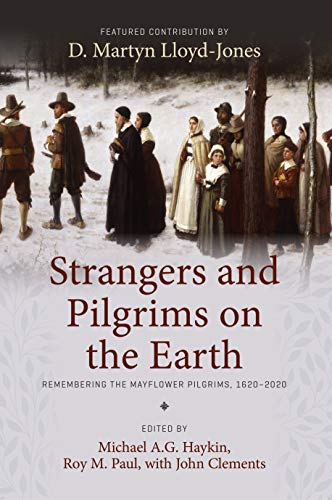A Book Review from Books At a Glance
by Andre Gazal
Another important addition to the plethora of monographs published to commemorate the four hundredth anniversary of the Pilgrims’ Mayflower voyage is Strangers and Pilgrims on the Earth: Remembering the Mayflower Pilgrims, 1620-2020, edited by accomplished church historian Michael Haykin, Roy Paul, and John Clements. This collection of essays closely examines not only the lives and careers of prominent figures among these Separatists, but important themes related to the principles that guided their bold experiment in Plymouth. Included are also essays devoted to subjects often neglected by evangelicals such as the influential role played by women among the Pilgrims.
The late Martyn Lloyd Jones’ essay sets the tone for the rest of the volume as it introduces the Pilgrims, highlighting the basic theological concerns that propelled them to take their treacherous voyage across the Atlantic to establish their community at Plymouth. From here, the essays move progressively, beginning with Jonathan Piesse and Adrian Gray’s chapters on John Robinson’s life, theology, career, and national context.
Following these two essays on Robinson is Michael Haykin’s superb chapter on the life and career of the important Puritan theologian, William Bridge, who supported the English Civil War, participated in the Westminster Assembly, and defended Scriptural authority against Quakerism. Complementing Haykin’s essay is Tom Nettles’ excellent survey of Francis Johnson’s controversial life and career in which he stresses the development of his Baptist theology that was especially steeped in concerns of freedom of conscience as the basis for religious liberty.
Chapters 6-16 move from specific key individuals to general themes related to the Pilgrims. Following essays on the Pilgrims’ voyage and the Brownist Emigration (Francis Bremer and Gary Brady respectively), is a very informative one by Nathan Tarr on the Pilgrims’ ecclesiological legacy. In this essay, Tarr argues very persuasively that the Pilgrims’ most significant achievement was that they established the first congregational form of church government in the New World which would substantially influence the subsequent development of the churches in Puritans’ Massachusetts Bay Colony.
Following Tarr’s essay is Andrew Ballitch’s chapter on William Brewster’s quest for religious liberty. Throughout this fascinating essay, Balitch argues that religious liberty was actually Brewster’s prime motivation for making the trans-Atlantic journey to Plymouth. However, in so arguing, Balitch is careful to situate Brewster’s, as well as his co-religionists’ conception of “religious freedom” in its actual historical context. In this regard, Balitch rightfully notes that Brewster and other Pilgrims understood such “freedom” as “Christian liberty,” the right to live and function as a Christian society according to his understanding of Scripture.
Complementing Balitch on Brewster is Roland Burrows’ chapter on the “First Critical Years” of the Pilgrims’ experiment in which he chronicles the enormous risks the Pilgrims faced in establishing their society in Plymouth that was defined by principles of self-government as outlined in the Mayflower Compact. Balitch and Burrows’ essays function together harmoniously to underscore the fact that the Pilgrims were willing to face existential threats to realize their understanding of “Christian liberty.”
These chapters provide a helpful backdrop for Jason Edwin Dees’ compelling chapter on the Mayflower Compact and its lasting influence on American values, among which were limited government, democracy, and ultimately submission to God. This explication of American values as informed by the Mayflower Compact seamlessly lends itself to David Roach’s chapter on the spiritual lessons of the First Thanksgiving. According to Roach, these lessons are: thankfulness flows from a high view of providence; Thanksgiving celebrations stem from a life of thankfulness; and the ability to think theologically enhances the celebration of Thanksgiving.
In chapter 13, Roy Paul examines the Pilgrims’ experience with Native Americans—a subject of considerable controversy today. Following Paul’s essay is Priscilla Wong’s engaging chapter on the Pilgrim women who shared in the vicissitudes of the community’s voyage and settlement, and Ryan Rindels’ chapter on the Pilgrims and religious liberty. Throughout this chapter, Rindels adroitly explains the concept of religious liberty conceived by the Pilgrims within their cultural context. As Rindels notes, the Pilgrims understood religious liberty to mean the freedom to worship and govern according to their conviction. Religious liberty, as defined here, differs substantially from the notion of “freedom of conscience,” later advocated by Roger Williams (1603-83), which the liberty of the individual to believe and act according to his/her personal convictions, whether they are informed by religion or not.
The last chapter by Nate Pickowicz concisely explicates the spirituality of the Pilgrims which emphasized devotion to God, devotion to Scripture, and devotion to a well-ordered society. Michael Haykin’s brief, but thoughtful afterward serves as a fitting affirmation of the importance of the Pilgrims’ experiment to American history despite the criminalization of them by the specious and excessively woke “1619 Project.”
Strangers and Pilgrims is indeed a fitting contribution to the thoughtful celebration of the Pilgrims’ daring voyage and experiment. The essays comprising this volume are lucidly written, explicating in-depth important aspects of the Pilgrims’ theology, spirituality, and daily life, all of which shaped the settlement of Plymouth, which in many ways served as the cradle of America. The volume is suitable for students, laypeople, pastors, as well as scholars. Strangers and Pilgrims serves as a helpful gateway into the Pilgrims as they understood themselves. It is an achievement that will aid considerably in reacquainting American Christians with this vital, but misunderstood aspect of our spiritual and national heritage.
Andre A. Gazal
Montana Bible College
